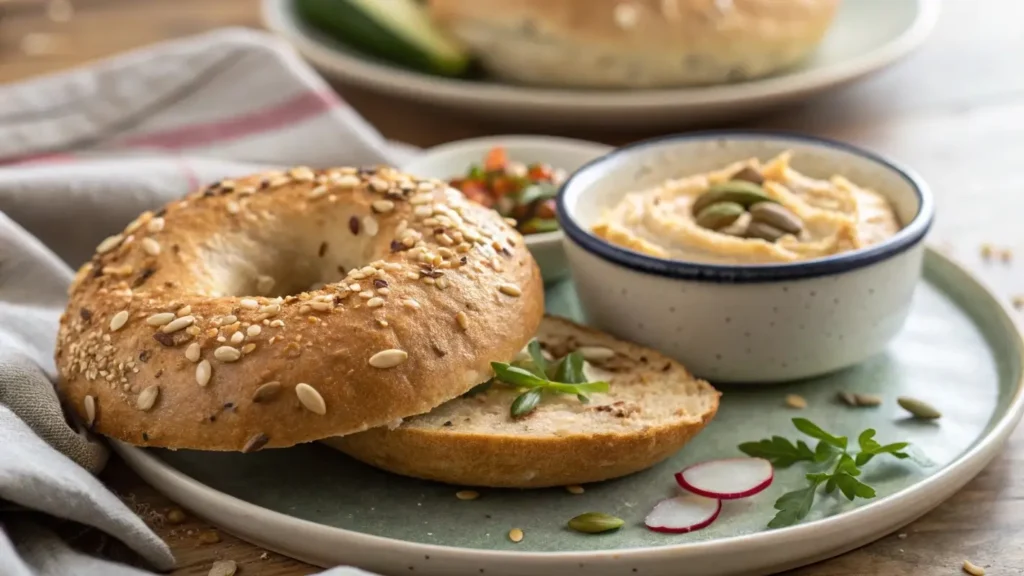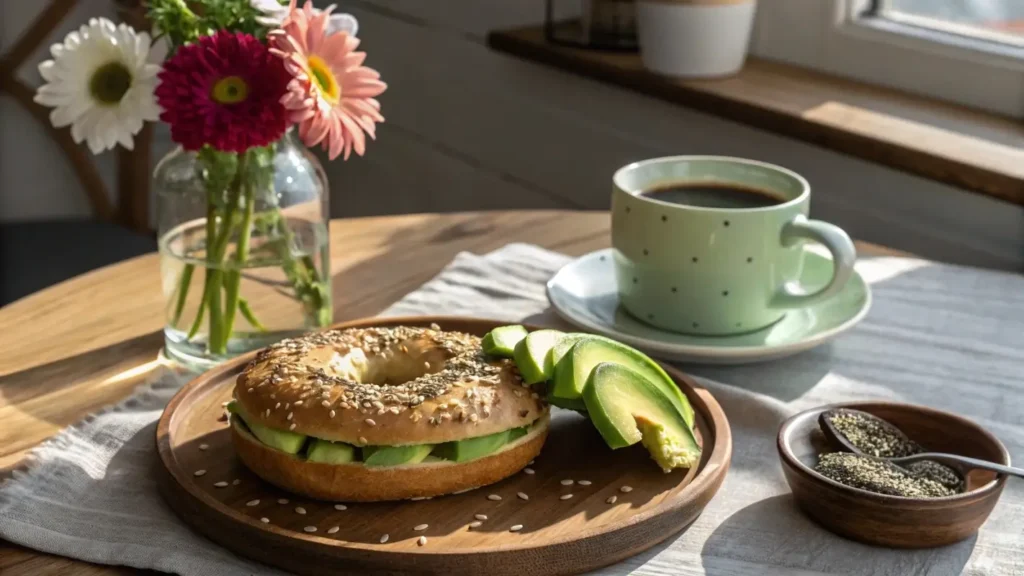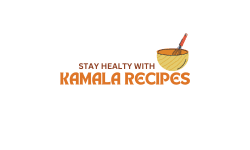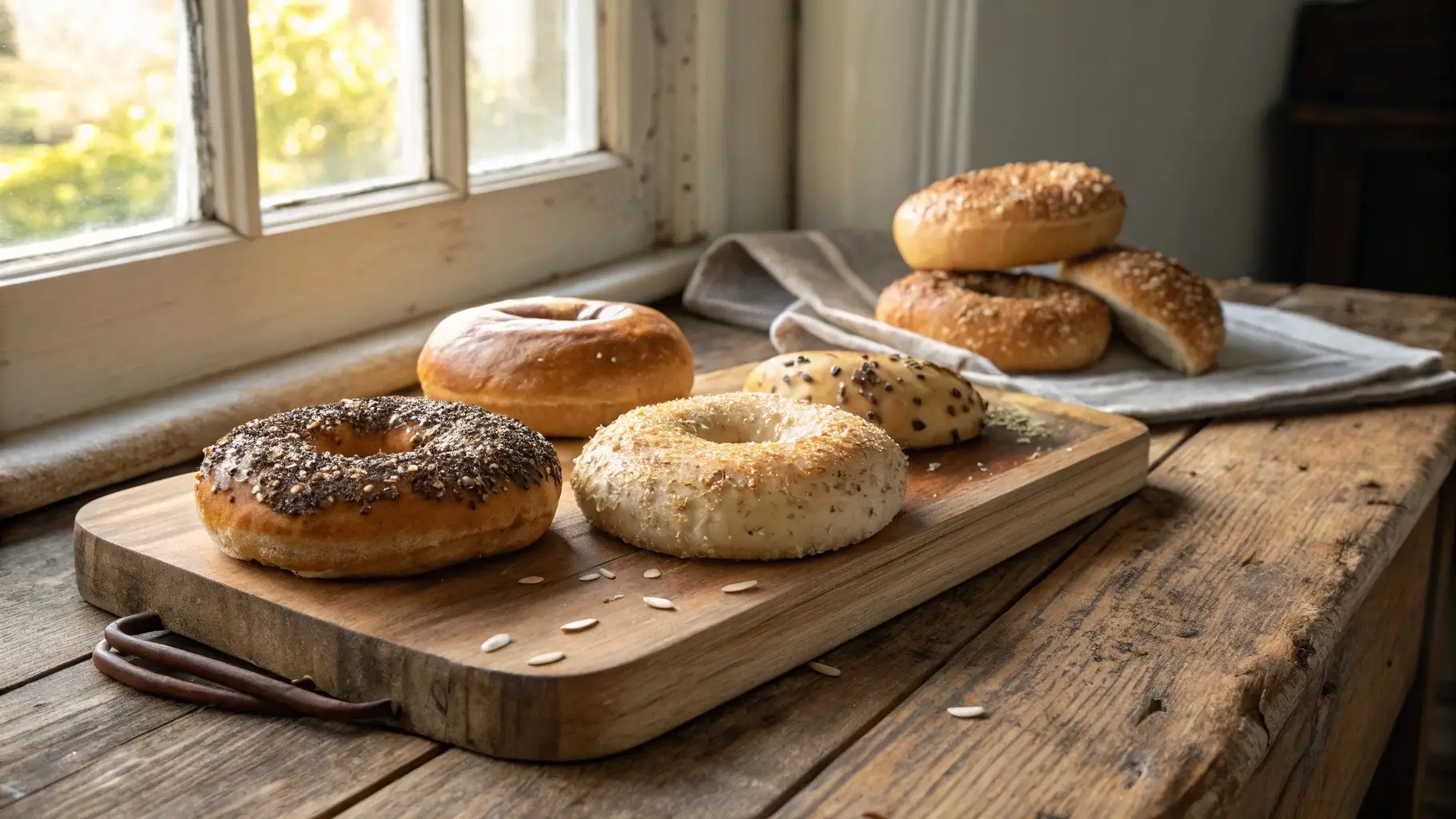What Are the Healthiest Bagels to Eat?
When it comes to breakfast, bagels are a timeless favorite. But if you’re wondering what are the healthiest bagels to eat, the answer depends on choosing the right ingredients and toppings. Not all bagels are created equal—some offer fiber and nutrients, while others are little more than empty carbs. In this guide, we’ll explore the healthiest options, how to make smarter choices, and ways to enjoy bagels without compromising your health.
Table of contents
- What Are the Healthiest Bagels to Eat?
- Introduction to What Are the Healthiest Bagels to Eat?
- What Are the Healthiest Bagels to Eat? Understanding Nutritional Criteria
- The Best Healthy Bagel Varieties
- Tips for Choosing What Are the Healthiest Bagels to Eat?
- Making Healthy Bagels at Home
- How to Top Your Bagel for Maximum Health Benefits
- Frequently Asked Questions About Healthy Bagels
- Conclusion
Introduction to What Are the Healthiest Bagels to Eat?
Bagels have a long and delicious history, but are they as healthy as they are tasty? In this section, we’ll break down their origins, nutritional basics, and why they’ve earned their spot on breakfast tables around the world.
A Brief History of Bagels
Bagels trace their roots back to Eastern Europe, originating in Jewish communities as early as the 17th century. Traditionally, bagels were boiled before baking, giving them their signature chewy texture and shiny crust. Today, they’re a global phenomenon, enjoyed plain, topped with seeds, or stuffed with savory or sweet fillings.
Nutritional Components of a Standard Bagel
A plain, traditional bagel is typically made with flour, water, yeast, and salt. One medium bagel contains about 250–300 calories, along with:
- Carbohydrates: Roughly 50 grams, which provide energy but can spike blood sugar.
- Protein: Around 9–11 grams, depending on the recipe.
- Fiber: Minimal in refined bagels, but higher in whole-grain options.
Bagels are also low in fat but can be high in sodium, especially flavored varieties. While they’re a good source of energy, traditional bagels lack vital nutrients like vitamins, minerals, and healthy fats.
Why Bagels Are a Popular Breakfast Choice
Let’s face it: bagels are irresistible! They’re versatile, easy to customize, and can be paired with countless toppings. Whether toasted with cream cheese or loaded with avocado and eggs, they’re a staple in many households. However, their popularity can lead to overconsumption, especially if healthier options aren’t chosen.
By understanding what’s inside your bagel and what to look for in healthier alternatives, you can make smarter choices without sacrificing flavor. Stay tuned as we dive into what makes a bagel truly healthy in the next section!
If you’re curious about the ingredients in a healthier variety, check out what is in a multigrain bagel for an in-depth breakdown.
What Are the Healthiest Bagels to Eat? Understanding Nutritional Criteria
Not all bagels are created equal. While some pack in fiber and protein, others are little more than empty carbs. But what exactly separates the healthiest bagels from the rest? Let’s explore the nutritional factors that determine a bagel’s healthiness and compare common varieties to find the best options.
Nutritional Criteria for a Healthy Bagel
When evaluating what are the healthiest bagels to eat, focus on these essential factors:
- Calories: A healthy bagel typically contains 200–250 calories. Overly large or calorie-dense bagels can contribute to excessive daily intake.
- Fiber Content: Fiber is essential for digestive health and keeps you feeling full. Look for bagels with at least 3 grams of fiber per serving. Whole-grain varieties usually excel in this category.
- Protein Levels: Protein helps maintain muscle and provides lasting energy. Bagels with 7–10 grams of protein per serving are ideal.
- Sodium Content: While sodium adds flavor, too much can raise blood pressure. Choose bagels with less than 400 mg per serving.
Comparing Regular Bagels with Healthier Options
Traditional white bagels are made from refined flour, offering little nutritional value beyond carbs. In contrast:
- Whole-Grain Bagels: Packed with fiber and nutrients, these are a heart-healthy choice.
- Sprouted Grain Bagels: These provide even more vitamins and minerals while being easier to digest.
- Low-Calorie Bagels: These options, often made smaller or with lower-carb ingredients, can help with weight management.
- Gluten-Free Bagels: Made for those with gluten sensitivities, these can be a good choice but may lack fiber unless fortified.

By focusing on these nutritional criteria, you can make better choices for your daily meals without compromising flavor or satisfaction.
Learn more about the benefits in this article: Is multigrain bagel healthy?.
The Best Healthy Bagel Varieties
If you’re wondering, what are the healthiest bagels to eat?, you’ll be glad to know there’s no shortage of options. From whole-grain powerhouses to innovative low-calorie versions, here are the top contenders for the healthiest bagel varieties.
Whole-Grain Bagels: The Nutrient Powerhouse
Whole-grain bagels are a gold standard for health. They’re rich in dietary fiber, essential vitamins like B6 and magnesium, and antioxidants. Unlike white flour bagels, they use minimally processed grains, retaining the bran and germ for added nutrients. Pair one with protein-rich toppings, and you’ve got a balanced meal.
Sprouted Grain Bagels and Their Benefits
Sprouted grain bagels take whole grains one step further by allowing the grains to sprout before grinding. This process increases nutrient availability and reduces anti-nutrients, making it easier for your body to absorb vitamins and minerals. Plus, they have a delightfully nutty flavor.
Gluten-Free Bagels for Special Diets
For those with gluten intolerance or celiac disease, gluten-free bagels are a lifesaver. Made with alternative flours like almond, coconut, or rice flour, they’re often lower in carbs. Just be sure to check the label for added sugars or fillers that can diminish their health benefits.
Low-Calorie Bagels: Reducing the Carb Load
If you’re watching your calorie intake, low-calorie bagels are a smart choice. Many brands now offer smaller portions or use lower-carb ingredients like cauliflower or oat flour. These alternatives satisfy your bagel craving without overloading your plate with unnecessary calories.
By choosing from these varieties, you can enjoy the satisfaction of eating bagels while nourishing your body. Plus, the wide array of options means there’s a healthy bagel for everyone, no matter your dietary needs or preferences.
Tips for Choosing What Are the Healthiest Bagels to Eat?
Walking through the bread aisle or scrolling online, you might feel overwhelmed by all the bagel choices. However, finding what are the healthiest bagels to eat becomes easier when you know what to look for. Let’s break down how to make the smartest picks.
Reading the Nutrition Label
Nutrition labels are your best friend when searching for healthy bagels. Start by checking the calorie count—around 200–250 calories per bagel is ideal. Next, examine the fiber content, which should be at least 3 grams per serving. Fiber not only keeps you full but also aids digestion. Lastly, look for protein—7 to 10 grams is a solid amount to sustain energy throughout the day.
Avoiding Added Sugars and Preservatives
Many bagels, especially flavored ones like cinnamon-raisin or blueberry, have a lot of added sugar. Too much sugar can make a healthy breakfast more like a dessert. Instead, choose plain or lightly flavored bagels. Also, watch out for preservatives or artificial ingredients, which can make a bagel less healthy.
Spotting High-Fiber and Protein-Rich Options
Whole-grain bagels and sprouted-grain varieties are excellent choices for fiber. If you’re aiming for a protein boost, consider bagels enriched with seeds like chia or flax. These options often provide a nutty flavor and extra nutrients, making them a win-win.
For more tips on nutritious foods, check out the healthy recipe section on Kamala Recipes. You might discover new ways to pair your bagels with wholesome spreads or toppings.
Making Healthy Bagels at Home
If store-bought bagels don’t meet your nutritional goals, why not try making your own? Homemade bagels give you complete control over ingredients, ensuring they’re as healthy and delicious as possible.
Simple Recipes for Homemade Bagels
Basic bagels only require a handful of ingredients: whole-grain flour, yeast, water, and salt. Mix the dough, shape it into rings, and boil before baking for that authentic chewy texture. You can also experiment with adding oats, seeds, or herbs to the dough for extra flavor and nutrients.
Healthier Substitutes for Traditional Ingredients
To reduce carbs, consider swapping some of the flour with almond or oat flour. Need a gluten-free option? Use gluten-free all-purpose flour. You can also cut back on sodium by using a lighter hand with the salt or a salt substitute.
Tips for Adding Nutritional Boosters
Amp up your homemade bagels by mixing in flaxseeds, chia seeds, or hemp hearts. These add a boost of protein, omega-3 fatty acids, and fiber. For a sweet twist, use natural sweeteners like honey or mashed banana instead of refined sugar.
Homemade bagels are not only healthier but also fresher and customizable to suit your taste. Once you start baking your own, you’ll never go back to store-bought.

How to Top Your Bagel for Maximum Health Benefits
A healthy bagel can quickly lose its nutritional value when paired with calorie-heavy spreads or sugary toppings. Choosing smart, nutrient-dense add-ons is key to maintaining balance. Let’s explore how to enhance your bagel with health in mind.
Choosing Nutritious Spreads and Toppings
The right spread can make or break your bagel’s health factor. Here are some of the best options:
- Hummus: Packed with protein and fiber, hummus adds a creamy texture without unnecessary fat. It’s also rich in vitamins like folate and iron.
- Avocado: This superfood is a fan favorite. Avocados provide healthy fats that promote heart health and keep you full longer. A sprinkle of salt and pepper enhances the flavor.
- Low-Fat Cream Cheese: For a classic choice, opt for a reduced-fat or plant-based cream cheese to cut down on saturated fat and calories.
Balancing Your Meal: Adding Proteins and Veggies
To turn your bagel into a complete meal, balance it with protein and fresh veggies:
- Protein Add-Ons: Add scrambled eggs, smoked salmon, or grilled chicken for a boost of protein. These options can help stabilize your blood sugar and keep you satisfied for hours.
- Vegetables: Pile on spinach, tomatoes, cucumbers, or sprouts for added crunch and nutrients. Veggies are low in calories and high in vitamins, making them an excellent addition.
By topping your bagel thoughtfully, you can create a meal that is both tasty and good for you. These combinations ensure you’re not just enjoying a bagel but also fueling your body with essential nutrients.
Frequently Asked Questions About Healthy Bagels
What type of bagel is the healthiest?
The healthiest bagels are usually whole-grain or sprouted-grain types. These are high in fiber, which helps with digestion and keeps you feeling full. Whole-grain bagels also have more nutrients, like iron and B vitamins, than bagels made with white flour. If you’re watching your calories or portion sizes, low-calorie or “thin” bagels are also good options.
Are egg bagels healthier than plain bagels?
Egg bagels can be slightly healthier than plain bagels, depending on your dietary goals. They usually contain more protein due to the addition of eggs in the dough, which can help keep you satisfied longer. However, they may also be higher in calories and cholesterol. If you’re aiming for a nutrient boost, egg bagels can be a good choice in moderation.
Can you get healthy bagels?
Yes, absolutely! You can find healthy bagels in stores or make them at home. Look for options labeled as “whole grain,” “sprouted grain,” or “low-calorie.” Gluten-free bagels can also be healthy for those with sensitivities, though it’s important to check the labels for added sugars or fillers. Homemade bagels are often the healthiest because you can control the ingredients and avoid preservatives.
What is the healthiest way to eat a bagel?
The healthiest way to enjoy a bagel is by pairing it with nutrient-rich toppings. Instead of butter or sugary spreads, try:
Fresh veggies like spinach, cucumber, and tomato for added vitamins.
Additionally, consider eating only half a bagel or opting for smaller-sized bagels to manage portion sizes. Pairing a bagel with a protein-rich side like eggs or a smoothie can also create a balanced meal.
Hummus or avocado for healthy fats.
Low-fat cream cheese or Greek yogurt for protein.
With these tips and insights, you’re now equipped to make smarter bagel choices.
Conclusion
Choosing what are the healthiest bagels to eat doesn’t have to be overwhelming. With a little knowledge and preparation, you can enjoy bagels as a delicious, guilt-free addition to your diet. Let’s recap the key takeaways to make your bagel choices healthier and more enjoyable.
Recap of Healthiest Bagel Options
From whole-grain and sprouted-grain bagels to low-calorie and gluten-free options, there’s a bagel for every taste and diet. Whole-grain bagels are packed with fiber and important nutrients, while low-calorie bagels work well if you’re watching your weight. No matter what you prefer, picking bagels made with simple, natural ingredients is the best way to stay healthy.
Final Tips for a Healthy Bagel Lifestyle
- Be Mindful of Toppings: Stick to nutrient-rich spreads like hummus or avocado, and add protein and veggies for a balanced meal.
- Portion Control Matters: If full-sized bagels feel too much, consider eating half or choosing “thin” bagels to reduce your calorie intake.
- Homemade Bagels Are Best: Making bagels at home allows you to control every ingredient, creating healthier and tastier results.
Bagels can still be part of a healthy diet. With these tips, you can enjoy the tasty chew of a bagel while sticking to your nutrition goals. Whether you buy them or make them at home, the healthiest bagels can fit into a balanced and satisfying lifestyle.

For additional inspiration on nutritious meal ideas, visit the Kamala Recipes homepage for a range of recipes to pair with your healthy bagels!

